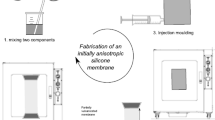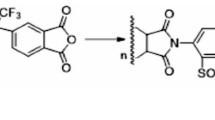Abstract
The main objective of this study is to generate anisotropic membranes stretched in their plane able to endure large deformations. In this perspective, different crenellated membranes were designed with a filled silicone rubber. The aim of this work is to build a constitutive equation which describes the mechanical behavior of such architectured membranes, by means of a simple decompostion of the strain energy. Since a filled silicone is used to make the architectured membrane, some non linear effects influence also the mechanical behavior of the structure. The main phenomenon is the Mullins effect and must be taken into account in the modeling. An equivalent constitutive equation is built for the architectured membrane by taking into account the mechanical behavior of the silicone and the geometrical parameters of the crenellated membrane. Firstly, a constitutive equation is chosen to describe the core of the membrane. Second, this equation is adapted to the behavior of the crenels and thirdly a coupling term describing the interactions between the crenels and the core of the membrane is developed. The implementation of the equivalent constitutive equation into a finite element code is finally validated on experimental data.













Similar content being viewed by others
References
Ashby M (2013) Designing architectured materials. Scr Mater 68:4–7
Bazant ZP, Oh BH (1986) Efficient numerical integration on the surface of a sphere. Z Angew Math Mech 66:37–49
Bouaziz O (2013) Geometrically induced strain hardening. Scr Mater 68:28–30
Bouaziz O, Brechet Y, Embury JD (2008) Heterogeneous and architectured materials: a possible strategy for design of structural materials. Adv Eng Mater 10:24–36
Brechet Y, Embury J (2013) Architectured materials: expanding materials space. Scr Mater 68:1–3
Diani J, Brieu M, Gilormini P (2006) Observation and modeling of the anisotropic visco-hyperelastic behavior of a rubberlike material. Int J Solids Struct 43:3044–3056
Dunlop JW, Fratzl P (2013) Multilevel architectures in natural materials. Scr Mater 68:8–12
Federico S, Grillo A, Imatani S, Giaquinta G, Herzog W (2008) An energetic approach to the analysis of anisotropic hyperelastic materials. Int J Eng Sci 46:164–181
Göktepe S, Acharya SNS, Wong J, Kuhl E (2010) Computational modeling of passive myocardium. Int J Numer Method Biomed Eng 27:1–12
Holzapfel GA (2000) Nonlinear solid mechanics—a continuum approach for engineering. Wiley, Chichester
Machado G, Chagnon G, Favier D (2010) Analysis of the isotropic models of the Mullins effect based on filled silicone rubber experimental results. Mech Mater 42:841–851
Machado G, Favier D, Chagnon G (2012a) Determination of membrane stress–strain full fields of bulge tests from SDIC measurements. Theory, validation and experimental results on a silicone elastomer. Exp Mech 52:865–880
Machado G, Chagnon G, Favier D (2012b) Induced anisotropy by the Mullins effect in filled silicone rubber. Mech Mater 50:70–80
Meunier L (2011) Contribution la conception, l’expérimentation et la modélisation de membranes hyperélastiques architcturées anisotropes. Ph.D. thesis, Université de Grenoble
Mooney M (1940) A theory of large elastic deformation. J Appl Phys 11:582–592
Mullins L (1948) Effect of stretching on the properties of rubber. Rubber Chem. Technol. 21:281–300
Natali AN, Carniel EL, Gregersen H (2009) Biomechanical behaviour of oesophageal tissues: material and structural configuration, experimental data and constitutive analysis. Med Eng Phys. 31:1056–1062
Nerurkar NL, Mauck RL, Elliott DM (2011) Modeling interlamellar interactions in angle-ply biologic laminates for annulus fibrosus tissue engineering. Biomech Model Mechanobiol 10:973–984
Rebouah M, Machado G, Chagnon G, Favier D (2013) Anisotropic Mullins stress softening of a deformed silicone holey plate. Mech Res Commun 49:36–43
Reese S, Raible T, Wriggers P (2001) Finite element modelling of orthotropic material behaviour in pneumatic membranes. Int J Solids Struct 38:9525–9544
Rey T, Chagnon G, Le Cam J-B, Favier D (2013) Influence of the temperature on the mechanical behavior of unfilled and filled silicone rubbers above crystallization temperature. Polym Test 32:492–501
Spencer AJM (1971) Theory of invariants. Contin Phys 1:239–352
Author information
Authors and Affiliations
Corresponding author
Rights and permissions
About this article
Cite this article
Rebouah, M., Chagnon, G. & Favier, D. Development and modeling of filled silicone architectured membranes. Meccanica 50, 11–24 (2015). https://doi.org/10.1007/s11012-014-0065-0
Received:
Accepted:
Published:
Issue Date:
DOI: https://doi.org/10.1007/s11012-014-0065-0




